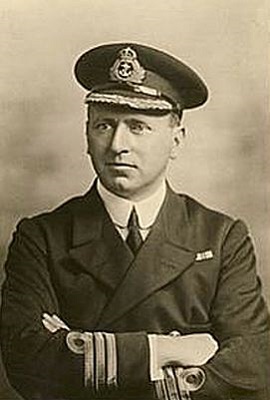Commander Loftus Jones VC

A total of four Victoria Crosses were awarded for the Battle of Jutland, fought near Denmark on 31 May-1 June 1916. Several of them are well-known, including those to Jack Cornwell of HMS Chester and Francis Harvey of the Royal Marine Light Infantry. However, few today are aware of Commander Loftus Jones and his actions that led to the posthumous award of Britain’s highest award for valour ‘in the face of the enemy’.
Born on 13 November 1879, Loftus Jones was the second son of Admiral Loftus Jones of Petersfield in Hampshire. He would be educated at Eastman’s Naval Academy in Fareham, after which he joined the training ship HMS Britannia in 1894.
Following completion of his training, he was appointed midshipman aboard the cruiser HMS Flora in 1897. As a sub-lieutenant, he would serve aboard HMS Spiteful in 1901, later being promoted to lieutenant and command of the torpedo boat HMS Sparrowhawk in 1903. Although he had experience of serving in bigger ships, he spent much of his service aboard a succession of torpedo boats, including: HMS Success (1905-08), HMS Chelmer (1908-10) and HMS Ghurka (1910-13). However, in 1913 he was to take command of the larger HMS Linnet, a Laforey-class (or L-class) destroyer.
Promotion to commander came on 30 June 1914, when he was next given command of HMS Shark, a Acasta-class destroyer that had been launched in 1912. While in command of this vessel, Jones would lead a small flotilla of four ships against a larger force of German cruisers – who were conducting a raid on Scarborough – off the east coast of England in December 1914. He would receive much praise from Admiral David Beatty for his efforts and courage.
During the Battle of Jutland, Jones was again in command of HMS Shark and the 4th Destroyer Flotilla when he confronted a number of German destroyers en route to engaging a squadron of Royal Navy battlecruisers. In the ensuing action, the Shark would be badly damaged and Jones wounded. However, the commander and his crew fought on until he was eventually forced to issue orders to his men to abandon ship. At 19:00 hours on the first day of the battle, a German submarine finally sank the battered destroyer with a torpedo. A total of eighty-five crew of the Shark perished, with a further three being wounded.
Jones was last seen attempting to hold on to a life-raft, but it is believed he finally died due to loss of blood. His body was eventually washed-up on the Swedish coast, where he was buried in the churchyard at Fiskebaksil on 24 June.
The citation for Jones’ Victoria Cross, which was published in the London Gazette of 6 March 1917, offers more details of his actions during the battle:
‘On the afternoon of the 31st May, 1916, during the action, Commander Jones in H.M.S. “Shark”, Torpedo Boat Destroyer, led a division of Destroyers to attack the enemy Battle Cruiser Squadron. In the course of this attack a shell hit the “Shark’s” bridge, putting the steering gear out of order, and very shortly afterwards another shell disabled the main engines, leaving the vessel helpless. The Commanding Officer of another Destroyer, seeing the “Shark’s” plight, came between her and the enemy and offered assistance, but was warned by Commander Jones not to run the risk of being almost certainly sunk in trying to help him. Commander Jones, though wounded in the leg, went aft to help connect and man the after wheel. Meanwhile the forecastle gun with its crew had been blown away, and the same fate soon afterwards befell the after gun and crew. Commander Jones then went to the midship and the only remaining gun, and personally assisted in keeping it in action. All this time the “Shark” was subjected to very heavy fire from enemy light cruisers and destroyers at short range. The gun’s crew of the midship gun was reduced to three, of whom an Able Seaman was soon badly wounded in the leg. A few minutes later Commander Jones was hit by a shell, which took off his leg above the knee, but he continued to give orders to his gun’s crew, while a Chief Stoker improvised a tourniquet round his thigh. Noticing that the Ensign was not properly hoisted, he gave orders for another to be hoisted. Soon afterwards, seeing that the ship could not survive much longer, and as a German Destroyer was closing, he gave orders for the surviving members of the crew to put on lifebelts. Almost immediately after this order had been given, the “Shark” was struck by a torpedo and sank. Commander Jones was unfortunately not amongst the few survivors from the “Shark” who were picked up by a neutral vessel in the night.’






